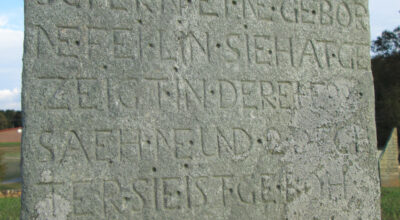Local churches kick off relief efforts
Published 12:00 am Saturday, November 16, 2013
Throughout Jesus’ ministry, he spoke consistently about helping those who are in need.
In 1 John 3:17, we read, “If anyone has material possessions and sees a brother or sister in need but has no pity on them, how can the love of God be in that person?”
That’s why it’s no surprise that local churches consistently respond to needs whenever they arise.
Take, for example, the Missions of Mercy Dental Clinic that was held in Salisbury in September. There were so many local volunteers from the downtown churches that folks had to be turned away from helping. That had never happened before, clinic organizers said.
But churches here have local as well as global awareness. Whenever and wherever a disaster occurs, they stand ready to help.
That is true of the most recent global disaster, the aftermath of the typhoon in the Philippines.
The downtown churches funnel money to their local state or national disaster relief organizations. That way, they are assured that 100 percent of the money is sent into the field to provide aid as quickly as possible.
“We strive daily to be ready to respond as soon as it is practical after a disaster,” said Gaylon Moss, disaster relief director for North Carolina Baptist Men. “Domestically, it can be moments. Internationally, it can be weeks.”
In an email sent to parishioners early this week, The Rev. Rhodes Woolly, senior pastor of St. John’s Lutheran Church said The Philippines typhoon has been “devastating and painful to watch.”
“We have a special opportunity to help our neighbors there by contributing to the ELCA’s Lutheran Disaster Response,” he wrote. “Because the ELCA covers all staff and office expenses, 100 percent of your contribution goes directly to people in need.
“You should feel confident that Lutheran Disaster Response is recognized around the world as one of the most effective disaster relief organizations anywhere.”
ELCA stands for Evangelical Lutheran Church in America.
Likewise, Dr. Jim Dunkin, senior pastor of First Presbyterian Church, alerted his congregation with a similar email.
“A beacon of hope for me occurred by going to our denomination’s website to see how Presbyterian Disaster Assistance is already hard at work on behalf of all Presbyterians,” he wrote. “As people seek ways to help, we hear that we should support national agencies so that we know our help goes directly to the tragedy.
“For constant updates on what our church is doing by bringing hope to a people of despair, I hope you will go to our denomination’s website as you continue to pray for our sisters and brothers in the Philippines.”
Moss said his ministry uses monetary donations to purchase supplies.
“We are in the planning stages now for the Philippines, but we will be buying water purification units with money that has been donated,” he said.
Sacred Heart Catholic Church has a special connection to the disaster.
“Since we at Sacred Heart have Dominican Sisters from the Philippines, we are also assisting the sisters (Dominican Sisters of St. Catherine of Siena),” said the Rev. John Putnam. “Sacred Heart School will have a ‘dress-down’ day and the monies raised will go to the Dominican sisters, who are already heavily involved in the relief effort.”
Putnam said the church will also be responding to the disaster through Catholic Relief Services and other Catholic groups.
“Any monies collected are sent via the Diocesan Offices to these agencies,” he said.
In our world of instant news, the fact that we see disasters happen in real time doesn’t mean that we can provide help as quickly as we would like.
“Right now, our North Carolina Baptist Men are providing assistance,” said Brian Farmer, associate pastor of First Baptist Church. “They can respond quickly with shower trucks and feeding trucks domestically.”
But international assistance is a bit trickier to manage, Farmer said, because of lack of transportation or lack of communication in an affected area.
“You can have all the money in the world, but the ability to respond to needs cannot be immediate.”
That’s certainly true in the Philippines, where the priority is opening the airport, clearing debris and getting aid shipments coordinated.
Still, Farmer said, his congregation is always willing to help in the aftermath of a crisis.
“We don’t even need to ask,” he said. “When disasters like this happen, people ask, ‘What do we need to do?’”
Moss said money is the best thing people can give.
“Translating that into direct services to the individual can be the hard part,” he said.
Members of First United Methodist Church have already started giving to the Philippines relief effort. Their funds will go to UMCOR, the United Methodist Committee on Relief.
“They are a very giving congregation,” said Amy Wagoner, the church’s administrative assistant. “When the need is there, they rise to the occasion.”
Mark Ritchie, a member of St. John’s, said he’ll likely contribute to the ELCA fund.
“I do tend to respond when there is some disaster that the ELCA is involved with,” he said. “We are all interconnected. Our oneness brings a responsibility to reach out when the other is in need.
“We all have the responsibility to love our neighbor.”
Immediate giving is not an uncommon response. According to the Center for Disaster Philanthropy, more than one-third of private giving occurs within the first four weeks of a disaster, and close to two-thirds happens in the first two months.
Yet that giving stops within six months. The center noted that in 2010, it would take 11.5 years for communities affected by Hurricane Katrina to recover.
As we all know, however, a news cycle doesn’t last nearly that long, and another disaster will fling itself into our national consciousness soon enough.
“That’s the plain, hard reality of disaster work,” Moss said. “There’s a very small window for awareness and fundraising.”
Freelance writer Susan Shinn lives in Salisbury.


